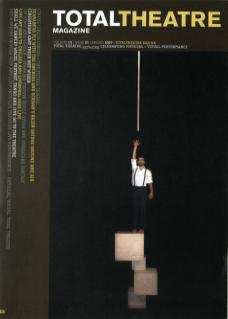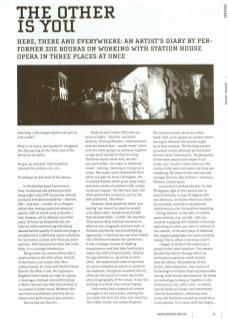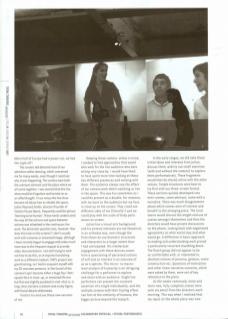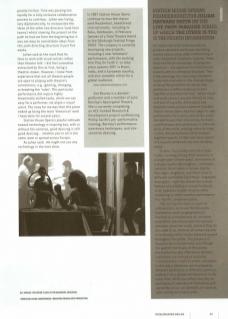How long is the longest phone call you’ve ever made?
Mine is six hours, during which I imagined the day passing at the other end of the phone as we spoke.
He got up, dressed, had breakfast, cleaned the kitchen, etc, etc.
Or perhaps he did none of the above.
In the last few years from time to time I’ve devised and rehearsed online using audio-only VOIP (voice over internet protocol) with devisers both far – Helsinki, USA – and near – London. It’s a cheaper option than renting expensive rehearsal spaces, with no travel costs or hassles. I had, however, yet to rehearse via online video. At home we frequently now use internet video conferencing with family abroad but the quality of sound and image is variable and it is definitely a poor substitute for live human contact with those you know and love. With those you’ve never met in the flesh, it is a strange introduction.
Being online via camera allows only a small window to the other place. Outside of the frame is an unseen and often unheard world. So it was with Station House Opera’s The Other Is You. We (a group in Brighton) were linked via video to a group in Groningen, Holland and another group in Berlin. We saw only what they showed us on camera in either venue. Whatever else was there and whatever else they did (in rehearsal or performance) was unknown.
But we had our theories…
Daily at one o’clock (UK time) our team of eight – director, assistant director, three performers, camerawoman, and two technicians – would ‘meet’ online with the other groups to rehearse together scripts we’d worked on that morning. The three teams never met; we only saw each other, via video, in rehearsal mode – waiting, listening or trying out a scene. The usual social interaction from which one gets to know colleagues, the incidental banter which gives away major and minor tones of another’s life, simply could not happen. For the most part, the other performers remained, just as the title predicted, ‘the other’.
However, what people do whilst ‘just waiting’ can reveal (or seem to reveal) a lot about them. Somehow we did feel that we knew them – a little. We saw their 2D personae daily and had reactions to what we saw, imagined, and were told. In Holland a performer was breastfeeding, apparently. In Germany we saw what looked like a flirtation between two performers. It was a strange mixture of nodding acquaintance and that fake familiarity a viewer has with a TV personality. Despite the gap between us, we relied on each other. We needed each other to be there on cue to complete an action or scene for the audience, though we ourselves did not often see the result on screen due to the physical geography of the venue. It was like working on a three-way virtual trapeze.
Each venue had a triptych of screens arranged in the same order, showing the live video link from the other two countries. The middle screen was always Brighton. The camera in each venue was often hand-held, so to appear on camera meant moving to wherever the camera might be at that moment. The blocking settled somewhat as the rehearsal period ended but was never fixed exactly. The geography of the other spaces took shape in our minds, but I found it never took over the reality of the space and place my body was inhabiting. My sense of here and now was stronger than my idea of there – Germany, Holland, virtual space.
In practice it worked like this: To look 90 degrees right of the camera was to look to Holland, to look 90 degrees left was Germany, no matter where you stood. So your body could be in any physical relationship to the live audience watching – facing, behind, to the side, in another space entirely, e.g. outside – but you could be engaging with Holland or Germany depending on where you were in relation to the camera. In the early days of rehearsal this slippery geography was quite mentally taxing (‘Sorry, where is Germany now?’).
I began to think of the camera as a portal to the other locations. The camera became the device through which my performance persona could connect with the others. The potential of this portal, while attractive, was a piece of technological trickery requiring impeccable timing, both human and machine. We relied on technology to keep us together in the three places, but, with a two- to twentysecond delay on visuals and intermittent internet breakdowns, rehearsals were tricky. We had been warned we would have to be patient. It is clever stuff but fragile... When half of Europe had a power cut, we had the night off!
The screens did demand most of our attention whilst devising, which concerned me for many weeks, even though I could see why it was happening. The screens were both the unknown element and the place where we all came together. I was worried that the live show would be forgotten and tacked on as an afterthought. In our venue the live show became all about how to inhabit the space. Julian Maynard Smith, director/founder of Station House Opera, frequently used the phrase ‘learning to be human’. These words underscored the way all the actions and space between actions was inhabited in the continuous live work. The dominant question was, however: How does this look on the screens? I don’t usually work with cameras or streamed image, although I have recently begun to engage with video much more due to the frequent request to provide video documentation. I am still trying to work out how to do this, as it requires translating work to a different medium. SHO’s project was good training, as I had to acquaint myself with my 2D on-screen presence. In the funnel of the camera’s eye I became either a huge four-feet-square face in close-up, or remained life size but flat and slightly pixelated in mid-shot or, in long-shot, became a distant and murky figure, with facial details obliterated.
I had to try and use these new versions of me.
Keeping these camera-selves in mind, I needed to find approaches that would also work for the live audience who were sitting very close by. I would have liked to have spent more time looking at these two different presences and working with them. The audience always saw the effect of our camera work whilst watching us live in the space. This was fun sometimes as I could be present as a double, for instance, with my back to the audience but my face in close up on the screen. They could see different sides of me (literally!) and we could play with the scale of body parts shown on screen.
Julian has a visual arts background and his primary interests are not theatrical in an orthodox way, even though the final shows do use dramatic structures and characters to a larger extent than I had anticipated. His intellectual engagement with these devices comes from a questioning of perceived notions of self and an interest in an overview of us as a species. This micro- to macro-level analysis of humanity is an intriguing challenge for a performer to explore and share with an audience. Single live performers can present the constant assertion of a single individuality, and the multiple screens with their tripling effect can hint at the similarity of humans, the bigger picture beyond the triptych.
In the early stages, we did take these initial ideas and interests from Julian, discuss them, and try out small exercises (with and without the camera) to explore them performatively. These fragments would then be shared online with the other venues. Simple structures were best to try first with our three-screen format. These sections quickly developed into mini-scenes, some abstract, some with a narrative. There was much disagreement about which scenes were of interest and benefit to the emerging piece. The local teams would discuss the weight and use of scenes amongst themselves and then the directors would have private discussions on the phone, coming back with negotiated agreements on what would stay and what would go. A difference in basic approach to making and understanding work proved a particularly recurrent stumbling block. The Dutch group did not appear to be as comfortable with, or interested in, abstract notions of persona, gesture, scene construction etc. Questions of motivation and other linear narrative concerns, which were asked by them, were not of key relevance to the piece.
As the weeks continued, more and more new, fully complete scenes were sent via email from the directors each morning. This was when I realised that my input on the whole piece was now greatly limited. Time was passing too rapidly for a fully inclusive collaborative process to continue. Julian was trying, very diplomatically, to incorporate the ideas of the other two directors (and their teams) whilst steering the project on the path he had set from the beginning but it was not easy to consolidate ideas from this joint directing structure in just five weeks.
Julian said at the start that he likes to work with visual artists rather than theatre folk. I did feel somewhat ostracised by this at first, being a theatre-maker. However, I know from experience that not all theatre people are open to playing with theatre’s conventions, e.g. ignoring, changing, or breaking the ‘rules’. This particular performance did require highly theatrically skilled tasks, which are not easy for a performer, let alone a visual artist. The irony for me was that this piece ended up being the most ‘theatrical’ work I have done for several years.
Station House Opera’s playful attitude toward technology is inspiring but, with or without the cameras, good devising is still good devising... whether you’re all in the same room or spread across Europe.
As Julian said: We might not use any technology in the next show.
STATION HOUSE OPERA’S FOUNDER/DIRECTOR JULIAN MAYNARD SMITH ON THE LIVE FROM PARADISE SERIES, OF WHICH THE OTHER IS YOU IS THE FOURTH INCARNATION
For some time it has been possible to produce telematic performances linking distant places using video conferencing or other dedicated telephonic systems. These have had the disadvantage of being very expensive – too expensive for most artists to work with in a rehearsal situation. Then a few years ago the improving affordable bandwidth available on the internet began to bring the possibility for artists and performers in different places to work together in a productive way – where visual and aural contact was not limited by time, and was of a quality where quick and detailed communication became feasible. Station House Opera had had ideas for web performance for a while, and at this point decided to put them into action, to make a performance with performers in different parts of the world, working online to make a joint, live performance which brought together aspects of their own local spaces in a visually combined, but non-existent, space.
To date, four productions have been made, involving linking three locations in a single town (Amsterdam), three towns in a single country (Birmingham, Colchester, London), three towns in Europe (Berlin, Groningen, Brighton), and three cities in different continents (Sao Paulo, Singapore, Newcastle). Each has shared the critical feature of presenting a live performance to an audience in each location while combining to create another performance in a ‘fourth’, imaginary space.
The aim has not been so much to communicate, as to use the distances (cultural as much as geographical) involved to articulate how we can force essentially unknown people into our own narrative about the world, and how they do the same to us, while we all remain equally a continuing active human presence spread throughout the globe. This presence is bound to be misunderstood, but through the specific narratives of the pieces, the similarities and differences between individuals are treated as unearthly coincidences or conflicts within characters. In this way a character can be played by different performers in different countries, making a story global and parochial at the same time, which can reflect inwardly on each person’s own idea of themselves and outwardly on our, as members of a species, utter similarity to each other.
In 2007 Station House Opera continue to tour the classic work Roadmetal, Sweetbread internationally, including to Baku, Azerbaijan, in February (winner of a Total Theatre Award at the Edinburgh Festival Fringe 2005). The company is currently developing new projects, including a new ‘telematic’ performance, with the working title Play On Earth 2, to take place autumn 2007 in Brazil, India, and a European country, and also viewable online for a global audience. www.stationhouseopera.com
Zoe Bouras is a deviser/ performer and a member of Julia Barclay’s Apocryphal Theatre. She is currently completing an ACE-funded Research & Development project synthesising Phillip Zarilli’s pre-performative training, Barclay’s performance awareness techniques, and site-sensitive devising.



